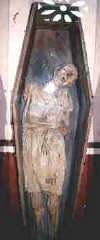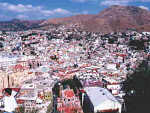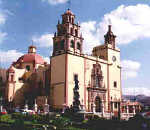|
![]()
Dawn was breaking. Church bells clanged in the Mexican village of Dolores.
Indians congregated for Mass.
September the 16th, 1810. Father Miguel Hidalgo gave a powerful sermon that immortalised him in Mexican history.
“El Grito de Dolores” the Cry went out to take up arms and overthrow the heartless government in Mexico City.
Hidalgo, a Mexican of Spanish descent, was a disaffected “criolla“, who despised the “peninsulares“, the privileged Government officials sent from Spain to rule the colony. Time was ripe for revolution.
In 1808 Napoleon invaded Spain and placed his brother on the throne. The colony of New Spain, ruled by a Viceroy resident in Mexico City, was effectively in limbo.
Hidalgo was appalled by the wretchedness of the Indian slave workers in the silver mines of nearby Guanajuato. He called for the abolition of slavery, equality for all Mexicans and an end to Spanish rule.
Conspirators, including Hidalgo, met regularly to plan the uprising with the Mayoress of Queretaro, using the “Society of Fine Arts” as a front organization. The Viceroy got wind of the conspiracy. That night a warning was conveyed to Hidalgo, who rang the church bells.
The rebels armed themselves with machetes, farm tools and slingshots to take on the trained and well-armed Spaniards. A raggle-taggle army of 20,000 criollas, metizos and Indians attacked Guanajuato where the outnumbered garrison of Spaniards and Royalists holed up in a grain storehouse, the Alhóndiga. They torched the gates and swept in to kill the defenders.
However, their initial victories were short-lived and the rebel army was defeated on approaching Mexico City. The Spaniards took revenge. Hidalgo and three other rebel leaders were executed. As a warning to others, their heads were strung up in iron cages and hung from the four corners of the Alhóndigo, in Guanajuato, where they remained from 1811 until the end of the War of Independance in 1822.
A “lottery of death” was instigated, whereby the names of Guanajuato citizens were drawn at random and the unlucky winners were tortured and hung.
The Guanajuato of today is a lively and happy place – Mexico’s gem of colonial architecture; a vibrant centre of music and the arts that hums along to the tune of 15,000 often boisterous university students.
|
![]()
I quickly discover the beautiful JardÃn de la Unión, the social centre which comes alive in the evenings. I admire the guitarists in flamboyant dress serenading the tourists in crowded hotel restaurants that spread onto the sidewalk beneath the trees. A band plays a jazzy tune from the ornate rotunda. By the magnificent Teatro Juaréz a student choir sings and a dance troupe performs outside.
A crowd gathers in front of San Diego church. A band of student songsters holding candles take off up an ancient alleyway and wend their way up the hillside. Like the Pied Piper, hundreds of people follow singing lustily and imbibing vino dispensed from flasks strung over a donkey. This fun weekend tradition, called the “callejoneados” must not be missed. Even now I can hear the hearty singing wafting on the cool midnight air.
The uniqueness of Guanajuato stems from its origins as a mining town built in a mountain ravine. Flat-roofed multi-storey stone houses cling to the hillsides accessed by cobble stoned alleyways, the callejones. Callejón del Beso is so narrow that lovers from adjacent houses can lean from their windows and kiss one another.
To establish a central flat area the ravine was partly filled in and with mining skills the main roadways were made underground, essentially eliminating the visual pollution and congestion of vehicular traffic from this colonial masterpiece.
|
![]()
On the outskirts is the Valenciana silver mine, started by the Spaniards in 1558 and is still operating on a small scale as a cooperative venture. For 250 years it produced 25% of New Spain’s (Mexico) silver.
Within sight of the mine’s head frame is the spectacular Templo La Valenciana, a cathedral completed in 1780 and financed by a silver baron. It was customary for wealthy mine owners to build a church to give thanks to God, and hopefully receive pardon for use of Indian slave labor thus ensuing a safe passage to Heaven.
The enormous wealth of the silver barons was spent on opulent mansions, churches and theatres, making Guanajuato one of Mexico’s finest colonial cities.
The attractions of this city are endless. Theatres, art galleries and museums abound. The Guanajuato School of Mines has a fine mineral museum worth a visit.
|
![]()
The Museum of Mummies is a macabre affair. Bodies are continually exhumed from the local cemetery to make room for others. Relatives have to pay an annual rental for a grave site. If you are in arrears then your beloved may end up on display in a glass case! It takes about 10 years for a body to become mummified.
Only a small percent of corpses are “display quality” and the rest are cremated. We found it crowded with classes of school children being ushered through by guides explaining the details of each corpse.
Diego Rivera is Mexico’s most famous painter and muralist. We first encountered his magnificent murals depicting life in early Mexico, in the National Palace, Mexico City. He was born in Guanajuato in 1886. The Museo y Casa de Diego Rivera honours him and has a small collection of his paintings.
I rest on the roof top of the guest house Casa Kloster. Students of Spanish sunbathe – American girls, Germans, Swedes – what a wonderful place to come and study. One day I will return and participate.
|
![]()
Let’s ascend the steep alleyways to the hilltop following the signs “Al Pipila” for a magnificent view of the city. The monument on the summit commemorates the Indian miner, Pipila, who torched the gates of the Alhóndiga, only to be mown down by a hail of bullets. Way below I can make out this fortress where Hidalgo’s rebels first tasted victory. A plaque on the statue is inscribed “Aun hay otras Alhóndigas por incidiar” – There are still other Alhóndigas to burn.
Guanajuato
Population 115,000, altitude 2017 meters, is one of the most beautiful cities in Mexico and the capital of Guanajuato State, located in the Northern Central Highlands.
It is very much a University town devoted to the promotion of the Arts. Language Schools are popular – this is a favorite spot for foreigners to come and learn Spanish. The city and nearby silver mines are now a UNESCO World Heritage Zone.
How to get there
By bus from Mexico City (Terminal Norte) 380 kms, 5 hours, cost ca. US$20; from Guadalajara 300 kms, 5 hours, $18. Guanajuato bus terminal is on the flat about 6 kms from the city center, which by taxi is about $2.50.
Accommodation
Budget guest houses and hotels cost US$8 to $11 per person. Check Lonely Planet – Mexico Guide for full range of accommodation available.
I’ve enjoyed staying at Casa Kloster (doubles 80 to 100 pesos/person), a family-run hospedaje located at Alonso #30 only a block from Plaza de la Paz. It is a favorite place for travellers and fills up quickly so it’s best to book ahead (phone 2-00-88).
Internet
At Alonso #70B is Redes Cybercafe (30 pesos/hr).
City Life
This revolves around the central Jardin de la Union with its immaculate 96 year old Indian laurel trees, sidewalk restaurants, cafes and ornate hotels.
Minstrels serenade the diners, student choir groups practice, bands play in the rotunda and orchestral groups perform in the adjacent Teatro Juarez… so it’s all go in the evenings.
It is a delight to wander around the winding cobble stone streets because all the major traffic and parking is underground.
City Tours
Several agencies run minibus tours to tourist localities on the outskirts of the city. The most convenient office is on Plaza de la Paz next to the Basilica.
|
A typical 4 hour tour (50 pesos, excluding entrance fees) takes in the Museo de las Momias the Valenciana mine site and nearby Templo La Valenciana (opportunity here to buy silverware), an underground tour of an old silver mine (El Nopal) and ending with a magnificent vista of the city from the El Pipila monument located above the Jardin de la Union.
Dolores Hidalgo
Population 40,000, altitude 1955 meters, is only 54 kms over the hills from Guanajuato. One hour by bus (Flecha Amarilla) every 20 minutes, also it is half way to the rival city of San Miguel de Allende, popular with foreign students.
Accommodation
We found Posada Dolores (Yucatan #8) very basic but conveniently located one block from the main plaza. For alternatives, see Lonely Planet Guide and town website.
Dolores Hidalgo is a fascinating place well worth a stopover to leisurely view the historical features associated with Mexico’s most famous hero; e.g., the Museo Casa de Hidalgo, Museo de la Independencia and the church where Hidalgo gave his call to arms.
Weather
The Guanajuato highlands have a fairly mild dry climate. Over the summer period (June to September) expect thunderstorms. Check the weather forecast now.
Exchange Rate
Currently US$1 = 9.8 Mexican pesos, but check the rate today.
The Author

You can visit Allano’s web site by clicking here.





